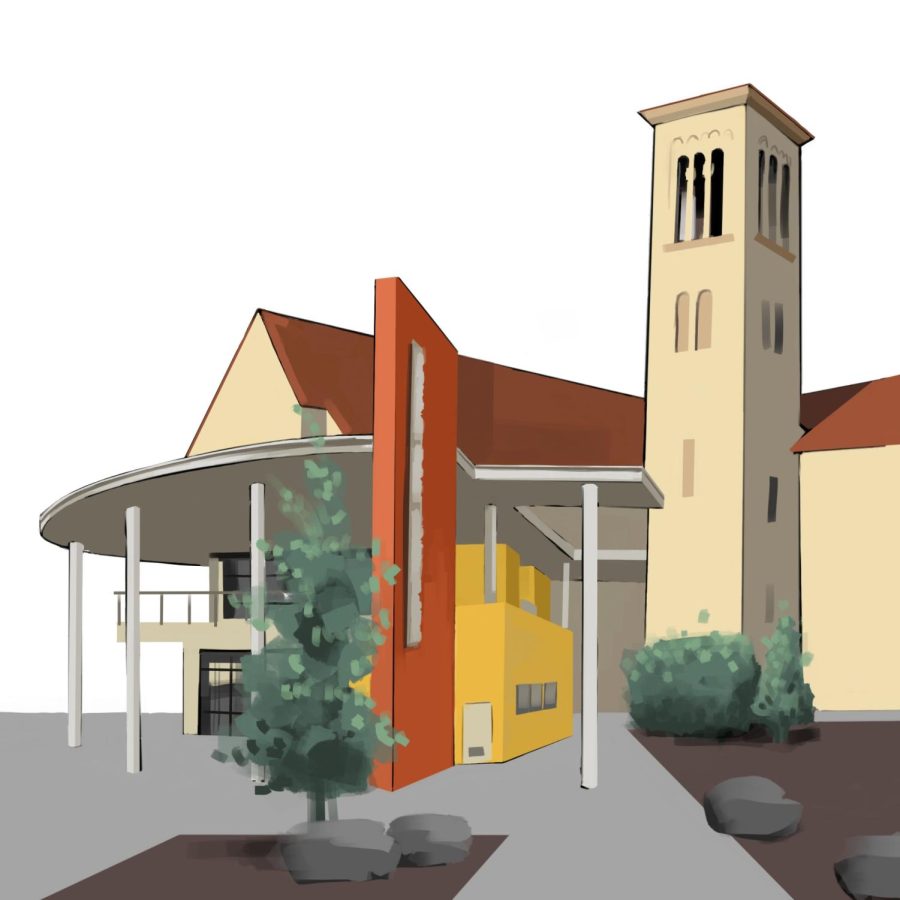Funding disparities lead to PAUSD facility differences
On May 21, 1964, the Palo Alto High School (Paly) Campanile published a story titled, “Henry Gunn nears completion; many unique features included,” which touted facilities such as the “950-seat auditorium, 2,000-seat football bleachers, 1,800-seat gym and a 10-lane, crushed-lava track.”
Recently, however, differences between Gunn and Paly’s campuses have grown, with Palo Alto Unified School District (PAUSD) spending more on improving Paly’s over the past decade than Gunn’s. The history behind the two sites is complex, involving public funding, private donations and relative facility ages.
Construction Funding
In PAUSD, school construction projects undergo a lengthy process for funding and approval, involving various organizations. The Board of Education approves each project and directs the overall plans, the equity committee promotes diversity and equity, and the bond oversight committee ensures projects align with the directives of government bonds.
The three groups come together to decide what facilities problems need to be addressed at each of the 17 schools in the district. According to Director of Facilities Eric Holm, the majority of the sites’ issues are reported by community members, including teachers, principals and parents. From there, the projects are prioritized from most to least important, before the project list and budget plans are approved by the Board of Education and formatted into a grant proposal.
After construction plans and funding methods are finalized, the district submits the specifications to the Division of the State Architect for approval. The entire process, from the initial project idea to the start of construction, can take around two to three years.
Gunn and Paly have similar acreages of developed space—such as athletic fields, classrooms and construction spaces—with 39 and 41 acres respectively. However, annual financial reports of the public bond program from 2011–2022 show that PAUSD spent $149.8 million in improving Paly’s campus while only $100 million was allocated to Gunn.
Board of Education Vice President Jennifer DiBrienza attributes the imbalance to the age of Gunn and Paly’s respective campuses. “[Paly] was the first high school [built in the district] so those buildings hit the end of life before [Gunn’s] buildings,” she said. “At some point, [the board] is going to say, ‘That building has hit the end of its life here at Gunn, so we’re going to need to replace it.’ That’s why Paly has newer buildings. [The same will] start happening [at Gunn] in the next couple of decades.”
The Peery Family Center—Paly’s new gymnasium complex—finished construction in May 2017 at a cost of $44 million. PAUSD, however, footed only $18 million, with the majority coming from a donation by the Peery Foundation. Paly’s state of the art complex cost significantly more than Gunn’s Titan Gym, which came in with a price tag of $12.9 million in 2012. While the Peery Center includes partitions to allow multiple teams to play at once, an athletic store and a coaches’ suite, the Titan facility only consists of a main gym, weight room and dance room.
Holm noted that the Peery Family Center was an anomaly, with 99% of PAUSD’s facilities funding coming from bond funds. The bonds that are still available to fund projects are the 2008 Measure A Strong Schools Bond and 2018 Measure Z Strong Schools Bond, providing $378 million and $460 million for expenditures on district facilities. Funds for both construction and maintenance of facilities in PAUSD come almost exclusively from bonds. Since the district’s founding in 1893, only two modern construction projects have been predominantly funded by private donations: the Peery Family Center at Paly and the multi-purpose room at Addison Elementary School. Paly was due for a new gymnasium, and with the Peery family donation, Paly’s new athletic center project was moved to the top of the project list. Paly’s original design would have been simpler, but the donation resulted in a more elaborate design and complex layout.
Recent Projects
The Building A, B and K construction project is part of the 2018 bond funds to renovate Gunn administrative workspaces and move science classes out of the Village portables. The project is currently projected to total $30.8 million, with plans to demolish and rebuild the area. The parallel project at Paly is the renovation of the original, 100-year-old Tower Building. The structure has needed significant repairs during the past decade, including a boiler replacement that cost nearly $1 million in 2012. Currently, the entire renovation and preservation of the Tower Building is estimated to cost $20.1 million.
One difference between the two schools is the technology in their theaters, both of which have undergone recent renovations. The Spangenberg Theater at Gunn includes basic lighting, audio and video services. On the other hand, the Performing Arts Center (PAC) at Paly has a Meyer Constellation sound system with improved acoustics and a two-way radio in addition to the features in Spangenberg.
Furthermore, the Gunn dressing rooms and green room do not directly lead to Spangenberg. Instead, the two areas are shared with the Little Theater; accessing the Spangenberg stage from the green room and dressing rooms entails long walkways and multiple sets of doors. In contrast, the PAC has backstage hallways, green rooms, bathrooms and dressing rooms that are all directly connected to the stage.According to Holm, the differences can largely be attributed to the two projects’—Gunn’s Central Building and Paly’s PAC—distinct needs. “Because [PAUSD] has older campuses, they are constantly in a state of renewal,” he said. “Paly [had] the PAC built because the Haymarket Theater was too old,” he said. “The addition to Spangenberg was an effort to provide classrooms that were needed for [subjects] that supported [Spangenberg and the arts].”
Although practical reasons may underlie some of the differences in Gunn and Paly’s facilities, many students have noticed the inconsistencies between the two schools. In a poll sent to all Gunn students with 200 respondents, over 90% of students surveyed said that the disparity between facilities was significant, with 36.8% saying that the difference was very significant. Junior basketball player Ethan Fu, who has played in both Gunn and Paly’s respective athletic facilities, commented on the matter. “I don’t think Paly’s better facilities give their team much of an upper hand,” he said. “The Paly facilities are definitely better though.” Having been on both campuses, former Paly student and now Gunn sophomore Nithila Subramanian has also noticed differences between the two facilities. “I’m on the fence about which school’s [campus] I prefer, but the differences between [Gunn and Paly] are stark,” she said.
Your donation will support the student journalists of Henry M. Gunn High School. Your contribution will allow us to purchase equipment and cover our annual website hosting costs.

Senior Charlotte Qian is a managing editor for The Oracle. In her spare time between writing articles and designing layouts, she enjoys playing with her...

Michael Zhang, a senior, is a Lifestyle editor for The Oracle. His interests include reading, writing and eSports. When he's not working on stories for...




